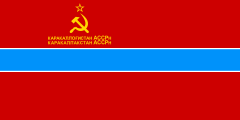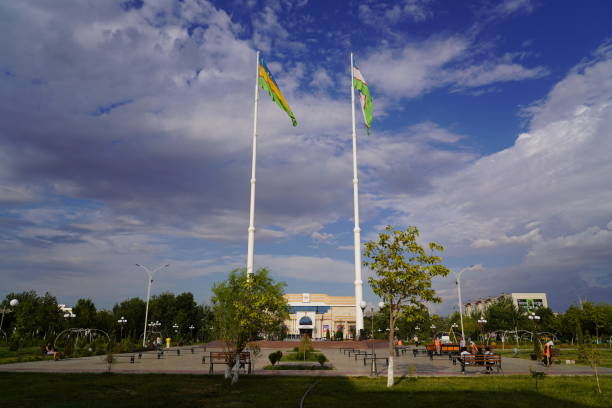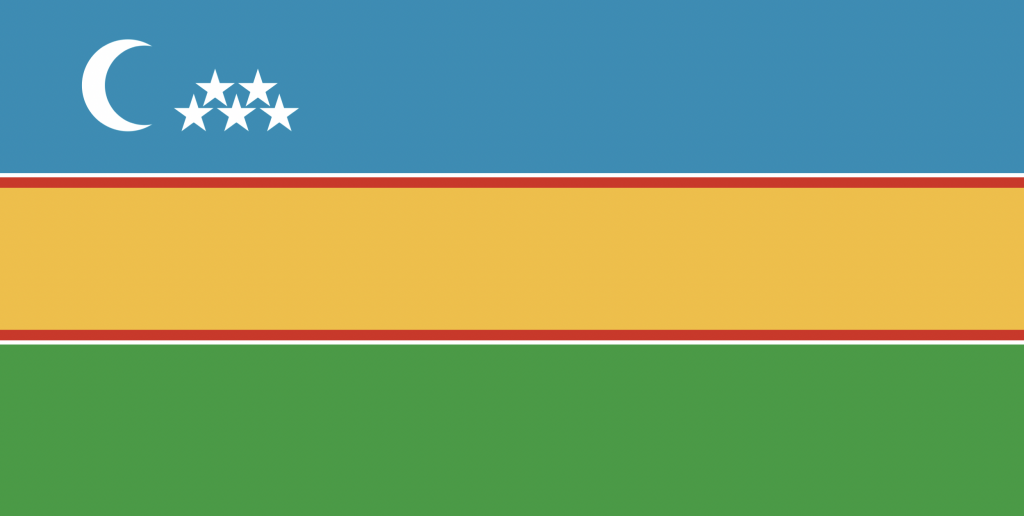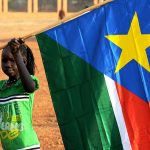Although Karakalpakstan is an autonomous republic within Uzbekistan, its flag stands as a powerful representation of the region’s distinct cultural and historical identity.
Nestled in the northwest of Uzbekistan, Karakalpakstan is a land of vast deserts, ancient traditions, and a rich tapestry of cultural influences that have shaped its unique character.

The flag of Karakalpakstan embodies the resilience and pride of the Karakalpak people, who have had to endure the destruction of the Aral Sea and collectivization, which aimed to destroy their nomadic way of life. As such, their flag now symbolizes this resilience – their deep connection to the land, their Turkic heritage, and their aspirations for a vibrant future.
With overlaps with the flag of Uzbekistan, the flag of Karakalpakstan also serves as a visual narrative of Karakalpakstan’s place within the wider Uzbek state. However, it also helps to honour the region’s autonomy and individuality.
Table of Contents
What historical flags were used in Karakalpakstan?
In the early history of the Karakalpak people, no centralized flag existed. Like many nomadic and semi-nomadic groups of Central Asia, the Karakalpaks were organized into clans and tribes, each with their unique symbols, banners, and colours that served to identify their groups. These banners often featured geometric patterns, crescent moons, and other motifs tied to Turkic and Islamic identity.
By the 19th century, Karakalpakstan had come under the control of the Russian Empire. During this time, the region had no distinct flag of its own and was administratively absorbed into the Turkestan Governorate. The imperial Russian flag flew over the region, symbolizing its incorporation into the empire. Local traditions and identity continued to thrive, but official symbols reflected the dominance of the Tsarist state.


Following the Russian Revolution in 1917, Karakalpakstan became part of the Turkestan Autonomous Soviet Socialist Republic (ASSR) under Soviet control. Initially, no specific flag represented Karakalpakstan, as it was incorporated into broader Soviet administrative structures.
In 1932, Karakalpakstan was designated as the Karakalpak Autonomous Oblast within the Kazakh ASSR, and by 1936 it became the Karakalpak ASSR, directly under the Uzbek Soviet Socialist Republic (Uzbek SSR). During this period, the Karakalpak ASSR adopted flags based on the standard Soviet design. These flags featured a red background with a gold hammer and sickle, along with text identifying the Karakalpak ASSR in both Cyrillic and the local language.
Uzbek Independence, Autonomy, and the Modern Flag
With the collapse of the Soviet Union in 1991, Uzbekistan declared independence, and Karakalpakstan became an autonomous republic within the newly formed nation. For the first time in its modern history, Karakalpakstan adopted a distinct flag, which was to reflect the region’s identity, natural environment, and cultural heritage.
It is not a coincidence that the flag of Karakalpakstan appears similar to the flag of Uzbekistan. This was done to demonstrate the integral standing of Karakalpakstan within the wider Uzbek state. You can read more about the history and profile of the flag of Uzbekistan here.
Where will I see the flag of Karakalpakstan used?
The flag of Karakalpakstan is widely displayed throughout the republic, particularly in government buildings, cultural institutions, and educational facilities. While Uzbekistan’s national flag takes precedence, the Karakalpakstan flag is a point of pride for locals, representing their unique place within the larger Uzbek state.
The flag also became a symbol of resistance during the Karakalpak protests of July 2022. They were sparked by proposed constitutional amendments that would have stripped Karakalpakstan of its nominal right to secede. Thousands of residents took to the streets in Nukus, the regional capital, to voice their opposition, citing concerns over the erosion of their autonomy and cultural identity.

The protests were met with a heavy-handed response, resulting in clashes, casualties, and a declaration of a state of emergency. While the Uzbek government withdrew the proposed amendments following the unrest, the Karakalpak flag had cemented its position as a symbol of resistance. This is despite the flag also being used by the Uzbek government.
Design and Symbolism of the Karakalpakstan Flag
The flag of Karakalpakstan is composed of three horizontal stripes—blue, yellow, and green—separated by narrow white and red bands. In the upper left corner, a crescent moon and five stars are prominently displayed on the blue stripe.

- Blue Stripe: Symbolizing the Amu Darya River and the expansive skies of the steppe, the blue stripe represents Karakalpakstan’s natural beauty and its lifeline, water. The Aral Sea, which has largely dried up, is still considered the lifeblood of the republic. Blue also reflects the Turkic heritage of the Karakalpak people.
- Yellow Stripe: Positioned in the center, the yellow stripe signifies the arid deserts and sunlit landscapes that dominate much of Karakalpakstan’s geography.
- Green Stripe: The green stripe at the bottom symbolizes the fertile lands and the hope for prosperity and growth in the region. Green also has cultural and religious significance, often associated with Islam.
- Red Stripes: Unsurprisingly, this is for the blood shed to achieve Karakalpak autonomy.
- White Stripes: Separating the other stripes, they are to symbolize harmony and peace among Karakalpakstan’s diverse communities.
- Crescent and Stars: The crescent moon and five stars in the upper left symbolize the Karakalpak people’s Islamic faith and aspirations for unity and progress. The five stars are also for the five major cities in Karakalpakstan.
In short, the design reflects a blend of cultural, natural, and spiritual symbolism that resonates deeply with the Karakalpak people.
How can I visit Karakalpakstan for myself?
As experts in Central Asia and specialists in organizing trips to unique and off-the-beaten-path destinations, we’re excited to help make your journey to Karakalpakstan a reality!
Our first group tour to the republic is coming soon, but we can also arrange private tours tailored to your schedule. Share your preferred dates, budget, and interests, and we’ll create a customized itinerary that suits your needs. Have questions or specific requests? Send us an email, and we’ll be happy to assist in planning your unforgettable adventure!
Want to learn more about Karakalpakstan before you visit? Don’t worry, we’ve got you covered! Why not check out our post, Visit Karakalpakstan, for all the insights and information you need about this incredible destination?





